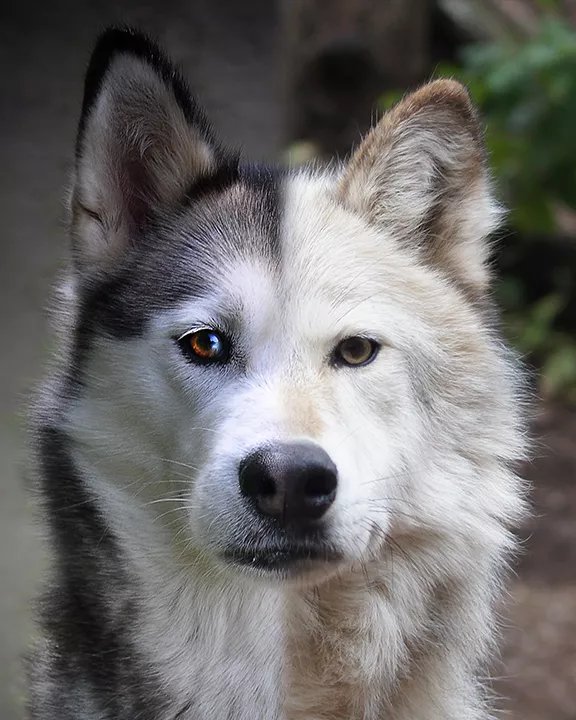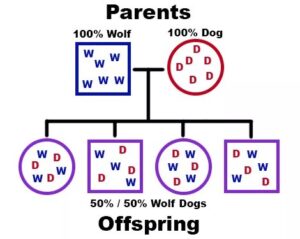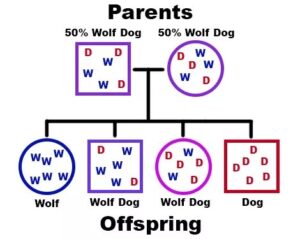A wolf dog is any canine with both domestic dog and wolf in its recent genetic ancestry and can result from any of the following parent combinations: a pure wolf and a pure domestic dog, a pure wolf and a wolf dog, two wolf dogs, or a wolf dog and a pure dog. Any breed of dog or subspecies of wolf are capable of producing viable offspring, though the chances of a toy poodle-wolf mix is extremely unlikely without human intervention in the breeding process due to the size difference between the parents.
Though it comes as a surprise to many, wolf dogs are almost exclusively a consequence of human manipulation. In the wild, wolves are generally, though not always, monogamous and extremely territorial by nature, viewing most other canines (wolves outside their pack, coyotes, and dogs) as competition for the resources necessary to survive. As a result, most wild wolves would likely react aggressively to a dog entering their territory, chasing them away or attempting to kill them rather than accepting them into a pack or viewing them as a potential mate. In addition, both male and female wolves are only capable of breeding once a year, so the likelihood of a free-ranging dog encountering a wild wolf of the opposite sex alone during breeding season (sometime between January and March) is very low.
So, if this is not a naturally occurring phenomenon, why do people intentionally create wolf dogs? There are numerous reasons, ranging from wanting to control a piece of the wild to mistakenly believing that they are creating a better “guard dog” to simply liking the “wolf look.” There is a misconception that breeding wolves and domestic dogs together will create the ideal blend of wild and domestic traits in the pups. However, these attempts to “reinvent the dog” hardly ever result in the ideal creature that most people are looking for.
It is quite common to hear the terms “wolf dog” and “wolf hybrid” used interchangeably to describe an animal with both wolf and dog genes. While both are technically correct, the term “hybrid” is considered to be the less desirable label for these animals. This is because many hybrids, such as the mule, are sterile as a result of the two parent species having differing numbers of chromosomes. However, since wolves and dogs are closely related genetically (sharing over 99% of their DNA) and have the same number of chromosomes, wolf dogs are an example of an intraspecific hybrid (a hybrid at the sub-species level), which are capable of producing viable offspring. Since they are inherently fertile, “wolf dog” is more commonly used.
WHAT IS WOLF CONTENT?
HOW IS WOLF CONTENT DETERMINED?
Assigning wolf content to an individual can be be very challenging. There are three methods with which wolf content can be judged: physical, behavioral, and genetic characteristics. The genetic component will be discussed in a latter section. It is important to note that determining an animal’s content based solely on one of these components is unlikely to yield accurate results.
Using physical characteristics to identify wolf dogs is known as phenotyping. There are dozens of physical features that can be used to distinguish between wolves and dogs including the shape and color of the eyes, the width of the chest, the shape of the muzzle, the length of the legs, the size of the paws, and numerous others. Phenotyping can be a difficult tool to use in identifying wolf dogs if not extremely familiar with how pure wolves look, as many dog breeds can have some features that are similar or even identical to those found in wolves. For example, a golden eye color is not unique to wolves. Thus, a golden eye color does not necessarily indicate that an animal has wolf content. Additionally, there are numerous domestic dogs that have been intentionally bred to resemble wolves, which can cause further complications in distinguishing between the two.
There can be similar issues using behavior to identify wolf dogs. One must have a keen understanding of how wolf and dog behaviors differ from one another to be able to use this strategy, and even this can be inaccurate. It is important to note that both an individual’s genetics and previous experiences contribute to its behavior. For example, a feral or poorly socialized dog may demonstrate cautious or flighty behaviors often observed in wolves, or a well-socialized wolf may be friendly and outgoing like a dog. Just because an animal acts “wolf-like,” does not necessarily indicate that the animal has wolf content.
In general, most sanctuaries and wolf dog experts use both physical and behavioral cues when assessing the content of a suspected wolf dog. As a result, they will not assign percentages to a wolf dog. Instead, they will assign the wolf dog into one of four basic categories: no-content, low-content, mid-content, and high-content.
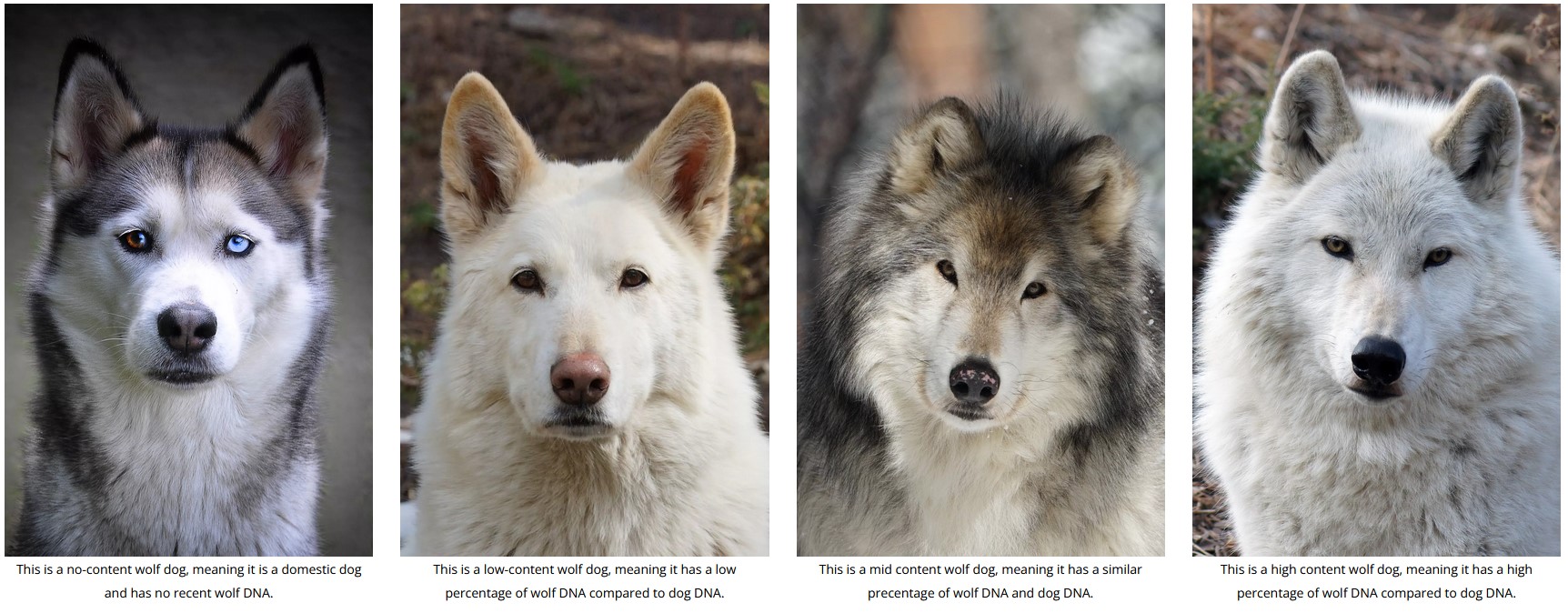
WHAT ABOUT DNA TESTING?
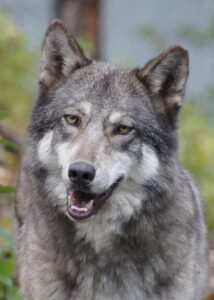 DNA testing is the third way of identifying a wolf dog and will often, though not always, give a percentage wolf content with the results. While DNA testing is considered by many to be the most accurate assessment, it is very important to understand that not all DNA tests or laboratories are equally accurate, nor do they all use the same methods and techniques to assess wolf content. Some look at the whole genome while others pick only a few genes to evaluate. Some labs use very recent techniques, while others may use older or rapid but less accurate methods. Some use a cheek swab to get DNA, others use blood samples, and some use hair or feces. Many labs also only use their own canid reference data rather than a universal set to which to compare results. It is also important to remember that DNA testing is an ever-evolving science with new advances in sequencing and technology occurring all the time. These variations can lead to large discrepancies in the reported results, and, just like with physical and behavioral assessments, all DNA results should be looked at with a critical eye and the acknowledgement of the potential for error.
DNA testing is the third way of identifying a wolf dog and will often, though not always, give a percentage wolf content with the results. While DNA testing is considered by many to be the most accurate assessment, it is very important to understand that not all DNA tests or laboratories are equally accurate, nor do they all use the same methods and techniques to assess wolf content. Some look at the whole genome while others pick only a few genes to evaluate. Some labs use very recent techniques, while others may use older or rapid but less accurate methods. Some use a cheek swab to get DNA, others use blood samples, and some use hair or feces. Many labs also only use their own canid reference data rather than a universal set to which to compare results. It is also important to remember that DNA testing is an ever-evolving science with new advances in sequencing and technology occurring all the time. These variations can lead to large discrepancies in the reported results, and, just like with physical and behavioral assessments, all DNA results should be looked at with a critical eye and the acknowledgement of the potential for error.
When selecting a laboratory to run a DNA test on a suspected wolf dog, it is very important to research the outfit offering the test before submitting one. Do not simply default to the cheapest or most convenient test available. Firstly, ensure that the test looks for wolf DNA, as many consumer dog DNA tests do not. Additionally, research the lab’s test methods and how accurate they are. What type of sample needs to be submitted? How much of the genome is sequenced to determine the content percentage? How are their results are reported? Some DNA labs are not detailed enough to give percentages and will simply respond with the labels “wolf,” “wolf dog,” or “dog” as their results. Finally, look at comparison reviews between the tests available to help determine which is the most accurate.


